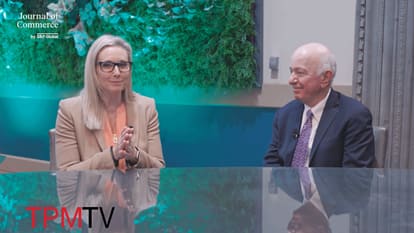- Program
- What's New
- Speakers
- Who's Attending
- TPM Community
- Partners

TPM Partnership
Partnership places your company in a position of authority and enables you to build and strengthen your relationships, visibility and reputation with major shippers
LEARN MORE - Media

TPM TV
Episodes of exclusive TPM content featuring interviews of key stakeholders and attendees.
WATCH NOW - About

About TPM
The must-attend conference for the trans-Pacific and global container shipping and logistics community
LEARN ABOUT TPM - Get Updates
- FAQ's
Sessions With Peter Sand
Tuesday, 5 March
-
02:15pm - 03:00pm (PST) / 05/mar/2024 10:15 pm - 05/mar/2024 11:00 pm
Trade Lane Focus: Surplus Capacity and Weak Demand Will Extend Asia-Europe's “Transition to Normalization”
Many in container shipping regarded 2023 as a “transition” year between the pandemic disruptions and a normalizing market, but judging from the weak demand and an unprecedented surge in capacity on the Asia-Europe trade, that transition will take longer. One of the greatest challenges for carriers over the next two years will be finding a way to somehow balance supply and demand. Estimates from various analysts put demand in 2024 at 3% while available capacity will grow by 7%. Maritime consultant Drewry estimates that 2.5 million TEU of capacity will be delivered globally by the end of 2023 and 3 million TEU in 2024. But at least 65% of the ordered tonnage consists of vessels with a capacity greater than 15,000 TEU, and the only place for most of that will be on the Asia-Europe trade. With little expectation of a great resurgence in demand among European consumers in 2024, the sheer capacity being deployed in 12-ship service strings will be difficult to fill. That spells disruption for cargo owners with carriers having little option but to continue aggressively blanking sailings, despite the strategy having little effect on plunging rate levels through the nonexistent 2023 peak season. With such a capacity overhang, carriers are simply unable to withdraw enough tonnage to make a material difference on rates. Where material differences are being made, however, is on service levels. Blank sailings, service cuts, and port emissions are preventing carriers from returning schedule reliability on Asia-North Europe to acceptable levels. Despite the almost complete absence of port and terminal congestion, vessels in the last quarter of 2023 were still struggling to reach an average on-time performance of 70%. Another costly issue looming over European importers and exporters is the European Union emissions trading system (ETS) that takes effect on Jan. 1, 2024. Starting in the first quarter, carriers will levy quarterly emissions surcharges on every container handled in the region. The actual surcharge per container will only become apparent early in 2024 when the trading in emissions allowances begins, but Asia-Europe shippers already are making it clear they want to negotiate the ETS surcharges within rate contracts.
Related content:
Spot rate gains puts pressure on shippers delaying Asia-Europe contracts: Xeneta Shippers to bring European ETS surcharge into carrier contract talks- Speakers:
- Michael Amri
- Antonios Rigalos
- Peter Sand
- Greg Knowler

